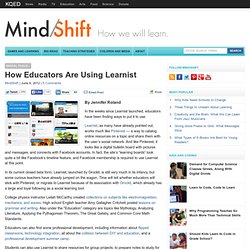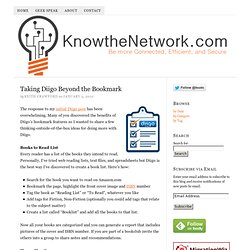

EduTecher.net - explore. share. contribute. How Educators Are Using Learnist. Digital Tools By Jennifer Roland In the weeks since Learnist launched, educators have been finding ways to put it to use.

Learnist, as many have already pointed out, works much like Pinterest — a way to catalog online resources on a topic and share them with the user’s social network. And like Pinterest, it looks like a digital bulletin board with pictures and messages, and connects with Facebook accounts. In fact, the site’s “learning boards” look quite a bit like Facebook’s timeline feature, and Facebook membership is required to use Learnist at this point. In its current closed beta form, Learnist, launched by Grockit, is still very much in its infancy, but some curious teachers have already jumped on the wagon. College physics instructor Leilah McCarthy created collections on subjects like electromagnetism, mechanics, and waves. Students can also use Learnist to share resources for group projects, to prepare notes to study for tests and write papers.
Related.
Skloog.com - Visual bookmarking made easy. Visual social bookmarking. Taking Diigo Beyond the Bookmark. The response to my initial Diigo post has been overwhelming.

Many of you discovered the benefits of Diigo’s bookmark features so I wanted to share a few thinking-outside-of-the-box ideas for doing more with Diigo. Books to Read List Every reader has a list of the books they intend to read. Personally, I’ve tried web reading lists, text files, and spreadsheets but Diigo is the best way I’ve discovered to create a book list. Here’s how: Search for the book you want to read on Amazon.comBookmark the page, highlight the front cover image and ISBN numberTag the book as “Reading List” or “To Read”, whatever you likeAdd tags for Fiction, Non-Fiction (optionally you could add tags that relate to the subject matter)Create a list called “Booklist” and add all the books to that list. Now all your books are categorized and you can generate a report that includes pictures of the cover and ISBN number.
House Hunting Writers Diigo becomes even more essential in a collaboration project. Educators Food Lovers. Useful Classroom Images. Diigo - Web Highlighter and Sticky Notes, Online Bookmarking and Annotation, Personal Learning Network. Content Curation with PearlTrees. Note: This post is also cross-posted over at the EasyBib blog.

I’ve written and spoken before about the essential skill (a literacy according to Howard Rheingold) of students not only being able to collect content from their network(s), but to curate what’s collected. Just like a museum curator pours over artifacts to find the very best to display, we should also do the same not just for our own professional resources, but see it as an obligation to model it for our students. I came across a new resource recently (I believe the hat tip goes to Alec Couros for this find) called Pearltrees.
After you sign up for your account, you can start building your own Pearltrees. Pearltrees are made up of “pearls”, or sites you want to curate into particular the Pearltrees (topics) you’ve created. Once you’ve signed up for your account, you will already have your “root” Pearltree created for you with your username. You will also see there that I have created a Pearltree called Digital Citizenship.